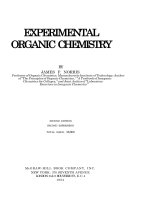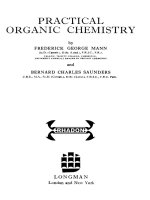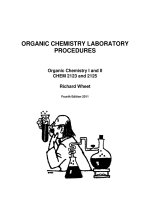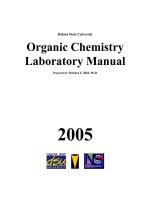Preview organic chemistry 100 must know mechanisms by roman valiulin
Bạn đang xem bản rút gọn của tài liệu. Xem và tải ngay bản đầy đủ của tài liệu tại đây (1.76 MB, 43 trang )
Roman A. Valiulin
Organic Chemistry: 100 Must-Know Mechanisms
Also of Interest
NMR Multiplet Interpretation.
An Infographic Walk-Through
Valiulin, 2019
ISBN 978-3-11-060835-9, e-ISBN 978-3-11-060840-3
Organic Chemistry.
Fundamentals and Concepts
McIntosh, 2018
ISBN 978-3-11-056512-6, e-ISBN 978-3-11-056514-0
Industrial Organic Chemistry.
Benvenuto, 2017
ISBN 978-3-11-049446-4, e-ISBN 978-3-11-049447-1
Molecular Symmetry and Group Theory.
Approaches in Spectroscopy and Chemical Reactions
Maurya, Mir, 2019
ISBN 978-3-11-063496-9, e-ISBN 978-3-11-063503-4
Diffusion and Electrophoretic NMR.
Stilbs, 2019
ISBN 978-3-11-055152-5, e-ISBN 978-3-11-055153-2
Roman A. Valiulin
Organic Chemistry:
100 Must-Know
Mechanisms
Author
Dr. Roman A. Valiulin
ISBN 978-3-11-060830-4
e-ISBN (PDF) 978-3-11-060837-3
e-ISBN (EPUB) 978-3-11-060851-9
Library of Congress Control Number: 2020931119
Bibliographic information published by the Deutsche Nationalbibliothek
The Deutsche Nationalbibliothek lists this publication in the Deutsche Nationalbibliografie;
detailed bibliographic data are available on the Internet at .
© 2020 Walter de Gruyter GmbH, Berlin/Boston
Cover image: Roman A. Valiulin (graphics), bestbrk / iStock / Getty Images Plus (background)
Typesetting: Integra Software Services Pvt. Ltd.
Printing and binding: CPI books GmbH, Leck
www.degruyter.com
Nothing in life is to be feared, it is only to be understood. Now is the time to understand
more, so that we may fear less.
— Marie Curie
Preface and Overview
Pedagogical Principles. At first, every body of knowledge that is new to us seems to
have boundless complexity and creates the initial impression of incomprehensibility
and even fear. Organic chemistry provides an excellent example of this phenomenon.
The discipline is replete with complex and initially abstract concepts, as a result the
information may seem overwhelming, particularly for the young chemist. But as with
most new subjects, consistent study and practice reveals patterns, commonalities,
rules, and an apparent logic. Eventually, an “architecture” becomes more apparent as we grow to become more experienced chemists. To develop this intuition, it
requires close study, repetition, and breadth of exposure. A significant element of
that learning is intrinsic and simply requires time and immersion. However, to help
with the development of this intuition, an organic chemist would also be wise to focus
on mechanisms for organic reactions as a foundation or anchoring point. This, in
combination with deep study, can help organize knowledge into skill and expertise.
An understanding of reaction mechanisms provides a solid foundation for the field
and a scaffold for further study and life-long learning. Mechanisms are highly useful
because they can logically explain how a chemical bond in a molecule was formed or
broken and help to rationalize the formation of the final synthetic target or an undesired side-product. Moreover, as we parse an increasing number of mechanisms, we
begin to see the similarities and an invisible conceptual “thread” then forms in our
mind’s eye that was not previously apparent. It helps to organize thinking and brings
sense to the otherwise foreign concepts such as reactive intermediates, transition
states, charges, radicals, and mechanistic arrows.
The Approach. To help galvanize – and perhaps catalyze – the organic chemist’s
inductive ability and to provide a “go-to” reference for closer study, this book strives
to present an abridged summary of some of the most important mechanisms. In
today’s terms, these are 100 MUST-KNOW Mechanisms. The author draws upon scientific knowledge developed through undergraduate and graduate years, including
post-doctoral research and study focused on organic synthesis. With a keen awareness of the incremental learning process, the book curates and presents mechanisms
by category, starting with the fundamental and basic mechanisms (e.g., nucleophilic
substitution or elimination), and mechanisms associated with the most well-known
named reactions (e.g., the Diels–Alder reaction or the Mitsunobu reaction). Additionally, the collection is complemented with historically important mechanisms
(e.g., the diazotization or the haloform reaction). Finally, it includes some mechanisms dear to the author’s heart, which he deems elegant or simply “cool” (e.g., the
Paternò–Büchi cycloaddition or the alkyne zipper reaction).
Organization. The mechanisms are organized alphabetically by chapter for ease
of reference, and numbered from 1 to 100. The dedicated student will consistently
proceed through every single mechanism, giving each one time to study, practice
with, memorize, and ponder. At the same time, the book can be used as a quick visual
/>
VIII
Preface and Overview
reference or as a starting point for further research and reading. The 100 mechanisms
are selected for being classic and famous, core or fundamental, and useful in practice.
Of course, a good degree of personal intuition is involved in the selection and it is
definitely not a dogmatic ordering or a comprehensive anthology. The book is intended to be a visual guide as distinguished from a traditional text book. The presentation of each mechanism constitutes a complete InfoGraphic (or “MechanoGraphic”)
and provides distilled information focusing on key concepts, rules, acronyms, and
terminology. It heavily focuses on the basic core – the starting amount of information,
the extract – that a good organic chemist can commit to memory and understanding.
Starting initially as a daily micro-blog post with a “hash tag” (#100MustKnowMechanisms) that gained a lot of support from students and chemists around the world,
the book is really intended to bring together an array of mechanisms, organize them,
provide additional historical context, and enable a conceptual space where the reader
can focus on learning them as well as serve as a desk-reference or a “flip-book”.
The book is color-coded: each key reaction is enclosed in a dark blue frame; each
key mechanism (the center piece of the book) is presented in a red frame; other reactions and mechanisms related to the core 100 mechanisms covered in this book are
usually summarized in grey frames. The book also collects a few useful rules, facts,
and concepts that are presented in green frames. The reader may find several star
diagrams, representing synthetic diversity, for example, throughout the book as well.
Relevant comments and clarifications can be found in footnotes.
Sources. The underlying information stays very close to information usually
covered in classic or key organic chemistry text books [1]. More specialized literature
may be necessary in some cases (for organometallic or photochemical transformations, for example) [2]. The reader is also encouraged to familiarize themselves with
some other supporting bibliography [3]. Where appropriate, it also references texts
that the author trusts and cites for further in-depth study if the reader so chooses.
Since this book strives to be an abridged visual illustration, students are encouraged
to use other, more comprehensive books on the subject, especially those related to the
named reactions in organic chemistry [4]. Additionally, open on-line sources, when
thoughtfully selected, can also be very useful [5]. Such sources may be mentioned
here when the information was deemed accurate, thorough, and supported by the
references. This is further supplemented by the author’s aggregate knowledge and
education gained through college, graduate school, and post-doctoral academic research. The author also found the encyclopedia of organic reagents [6] to be an extremely useful “go-to” starting point in his personal experience and professional career,
especially when embracing a new chemistry topic or using a new reagent. Moreover,
each MechanoGraphic is supported by reference to the likely first original publication
where the related reaction or mechanism was first mentioned (see the time-scale
after each mechanism). Finally, several key and fundamental reviews; publications
on recently elucidated mechanisms; and other research articles are referenced, as
needed. The author uses his best judgement in each case. However, even though the
Preface and Overview
IX
provided information was carefully checked, and presented in agreement with standard and accepted chemistry rules, this does not guarantee that it is free of all errors.
A further caveat, the variety of text and scholarly references does not imply a comprehensive and chronological review of the literature and history – it is not a global historic review of mechanisms from 1800‒2020. Mechanisms and our understanding of
them can also change as this book is being prepared and the corresponding literature
revised. Thus, the reader should supplement the use of the book with primary source
reading and deeper study through a comprehensive textbook prepared by a cohort of
experienced professors and experts. Here, the most common and known pathways,
those that do not violate basic standard chemistry rules and that are frequently referenced in the classic and contemporary literature, are summarized visually.
A Few Things to Keep in Mind. It is also important that the reader remain flexible and mindful that mechanisms are represented based on our current understanding, taking into consideration basic chemistry rules, valency, electron pushing
rules, charge preservation, Lewis dot structures, etc. They may not be the most
“cutting-edge” or up-to-date (e.g., cross-coupling reactions that may not be wellunderstood). They may also be substrate-dependent and each reaction may undergo
a slightly different pathway. Thus, the reader should not treat the book as a dogmatic
guide, and should keep an open mind for new data, creativity, and view the book as
part of a continuous debate in the subject.
Background Knowledge. To fully benefit from the book, the reader should have
basic knowledge of organic chemistry. Figures are presented with an assumption that
the reader understands common terms and symbols. Thus, basic concepts are not
introduced or explained. Undergraduate students, graduate students, scientists, teachers, and professors in the discipline should be able to utilize the book. The book can
also serve as a good condensed “refresher” for the experienced organic chemist who
wants to “zero-in” on the most basic and fundamental core mechanisms as judged by
the author.
The Inspiration and Further Reading. The author heavily draws upon his personal
experience as a student of chemistry and later an academic researcher. Never having
taken a formal course on mechanisms in organic chemistry, he approached the material initially through memorization as opposed to derivation. The first impression was
fear and a sense of being overwhelmed. However, after many years of experience,
more obvious patterns, trends, rules, and dependencies appear to have crystallized
providing an inductive ability to navigate and identify the mechanisms behind reactions. This personal experience has definitely shaped the teaching philosophy of the
book, and is further enhanced by the efficient way in which information can be conveyed through visuals and space. Moreover, as most individuals have a predisposition
for visual learning – this book is more intuitively aligned with the way that we seem to
learn the fastest. It strives to be a focused collection of the most useful, basic, and fundamental mechanisms. Started initially as a micro-blog post, the discussion, engagement, and interest it sparked indicated a clear need for a more-carefully prepared,
X
Preface and Overview
organized, and curated presentation in a format that could be placed in a physical
library and easily internalized. The author hopes the book serves as a good starting
point for the developing chemist who may need the most guidance and encouragement. No doubt it may stimulate constructive discussion, but nevertheless this
will ultimately encourage and challenge everyone to learn, to search for a different
answer, to think critically, and grow as a chemist and stay sharp as a scientist. Finally,
knowledge is a fractal-like concept, the closer we look the more detail we see and
learn. Here, we strive to reach a reasonable asymptote of precision and comprehensiveness given the purpose of the book. Further core reading [1], reference of primary
and secondary sources [2–4], and on-line sources [5 and 6] as well as actual experimentation and practice will help paint the complete picture and prepare the organic
chemist to be a well-rounded and informed scientist.
Contents
Preface and Overview
VII
List of Acronyms and Abbreviations
6
10
1
Electrophilic Addition Mechanism
2
Nucleophilic Substitution Mechanism
3
Aromatic Electrophilic Substitution Mechanism
14
4
Aromatic Nucleophilic Substitution Mechanism
16
5
Aromatic Radical Nucleophilic Substitution Mechanism
6
Elimination Mechanism
7
Acyloin Condensation
8
Alkyne Zipper Reaction
9
Arbuzov Reaction
10
Arndt‒Eistert Synthesis
11
Baeyer‒Villiger Oxidation
12
Barton Decarboxylation
13
Baylis‒Hillman Reaction
14
Beckmann Rearrangement
15
Benzoin Condensation
16
Benzyne Mechanism
44
17
Bergman Cyclization
46
18
Birch Reduction
22
26
28
30
48
32
34
36
38
42
40
12
18
2
Contents
19
Bischler‒Napieralski Cyclization
50
20
Brown Hydroboration
21
Buchwald‒Hartwig Cross Coupling
22
Cannizzaro Reaction
23
Chan‒Evans‒Lam Cross Coupling
24
Chichibabin Amination
25
Claisen Condensation
26
Claisen Rearrangement
27
Cope Elimination
28
Cope Rearrangement
29
Criegee & Malaprade Oxidation
30
CuAAC
31
Curtius Rearrangement
74
32
Darzens Condensation
78
33
Dess‒Martin Oxidation
34
Diazotization (Diazonium Salt)
35
Diels‒Alder Cycloaddition
36
Di‒π‒Methane Rearrangement
37
Favorskii Rearrangement
88
38
Fischer Indole Synthesis
90
39
Friedel‒Crafts Acylation & Alkylation
52
54
56
58
60
62
64
66
68
70
72
80
82
84
86
92
Contents
94
40
Gabriel Synthesis
41
Gewald Reaction
42
Glaser–Eglinton–Hay Coupling
43
Grignard Reaction
44
Grob Fragmentation
45
Haloform Reaction
46
Heck Cross Coupling
47
Hell–Volhard–Zelinsky Reaction
48
Hiyama Cross Coupling
49
Hofmann Elimination
50
Horner–Wadsworth–Emmons Olefination
51
Jones Oxidation
52
Kucherov Reaction
53
Kumada Cross Coupling
54
Ley–Griffith Oxidation
55
Liebeskind–Srogl Cross Coupling
56
Mannich Reaction
126
57
McMurry Coupling
128
58
Meerwein–Ponndorf–Verley Reduction
59
Michael Addition
132
60
Minisci Reaction
134
96
98
100
102
104
106
108
110
112
114
116
118
120
122
124
130
3
4
Contents
61
Mitsunobu Reaction
136
62
Miyaura Borylation
63
Mukaiyama RedOx Hydration
64
Nazarov Cyclization
65
Nef Reaction
66
Negishi Cross Coupling
67
Norrish Type I & II Reaction
148
68
Olefin (Alkene) Metathesis
150
69
Oppenauer Oxidation
70
Ozonolysis
71
Paal–Knorr Syntheses
72
Paternò–Büchi Reaction
162
73
Pauson–Khand Reaction
164
74
Peptide (Amide) Coupling
166
75
Pictet–Spengler Reaction
170
76
Pinacol–Pinacolone Rearrangement
77
Polonovski Reaction
78
Prilezhaev Epoxidation
79
Prins Reaction
80
Pummerer Rearrangement
81
Ramberg–Bäcklund Rearrangement
138
140
142
144
146
154
156
158
172
174
176
178
180
182
Contents
184
82
Reformatsky Reaction
83
Robinson Annulation
84
Shapiro Reaction
85
Sonogashira Cross Coupling
86
Staudinger Reaction
87
Steglich Esterification
88
Stille Cross Coupling
89
Suzuki Cross Coupling
90
Swern Oxidation
91
Ugi Reaction
92
Ullmann Aryl–Aryl Coupling
93
Upjohn Dihydroxylation
94
Vilsmeier–Haack Reaction
95
Wacker Oxidation
96
Wagner–Meerwein Rearrangement
97
Weinreb Ketone Synthesis
98
Wittig Reaction
99
Wohl–Ziegler Reaction
100
Wolff–Kishner Reduction
Acknowledgments
186
188
190
192
194
196
198
200
202
204
206
208
210
214
216
218
223
Bibliography and References
225
220
212
5
List of Acronyms and Abbreviations
≡
1°
2°
3°
Ac
acac
AdE2
AdE3
ADMET
AIBN
Alk = R
anti
APA
aq
Ar
B (B‒)
B2pin2
9-BBN
BH (BH+)
Bn
Boc
Bs
Bu
CHD
CM = XMET
con
3-CR (MCR)
4-CR (MCR)
CuAAC
CuTC
Cy
Cy2BH
DABCO
DBU
DCC
DCM
DEAD
DIAD
DIBAL = DIBAL-H
dis
DMAP
DMP
DMSO
Ee‒
E (or E+)
identical to [a depiction of a chemical structure]
primary [e.g., carbocation] or first generation [e.g., catalyst]
secondary [e.g., carbocation] or second generation [e.g., catalyst]
tertiary [e.g., carbocation] or third generation [e.g., catalyst]
acetyl
acetylacetonate
bimolecular electrophilic addition
trimolecular electrophilic addition
acyclic diene metathesis [polymerization]
azobisisobutyronitrile; 2,2′-azobis(2-methylpropionitrile)
alkyl group
from opposite sides (in anti-addition or anti-elimination)
3-aminopropylamine; 1,3-diaminopropane
aqueous [work-up]
aryl; aromatic ring
general Brønsted–Lowry base (proton acceptor)
bis(pinacolato)diboron; 4,4,4′,4′,5,5,5′,5′‐octamethyl‐2,2′‐bi‐1,3,
2‐dioxaborolane
9-borabicyclo[3.3.1]nonane
general Brønsted–Lowry acid (proton donor)
benzyl
tert-butoxycarbonyl; t-butoxycarbonyl
brosyl; 4-bromobenzenesulfonyl
butyl (if not specified = n-Bu)
1,4-cyclohexadiene
[olefin] cross-metathesis
conrotatory
3-component reaction (multi-component reaction)
4-component reaction (multi-component reaction)
copper(I)-catalyzed azide-alkyne cycloaddition
copper(I) thiophene-2-carboxylate
cyclohexyl
dicyclohexylborane
1,4-diazabicyclo[2.2.2]octane
1,8-diazabicyclo[5.4.0]undec-7-ene
N,N′-dicyclohexylcarbodiimide; 1,3‐dicyclohexylcarbodiimide
dichloromethane; methylene chloride
diethyl azodicarboxylate
diisopropyl azodicarboxylate
diisobutylaluminum hydride = (i-Bu)2AlH
disrotatory
4‐dimethylaminopyridine; 4-(dimethylamino)pyridine
Dess‒Martin periodinane
dimethyl sulfoxide
entgegen (trans- or opposite)
electron
electrophile
/>
List of Acronyms and Abbreviations
E1
E1cB (E1cb)
E2
EDC = EDCI
EDCI = EDC
EDG (= ERG)
Ei
eq
ERG (= EDG)
Et2BH
EWG
EYM
Grubbs 1°
Grubbs 2°
H3B•THF
H3B•Me2S = BMS
HATU
HBTU
HET = HETAr
HOAt = HOAT
HOBt = HOBT
HOMO
hν
Ii(BR)
Ii(RP)
IBX
IC
Ipc2BH
IpcBH2
ISC
KAPA
L
(l)
LA
LAPA
LDA
LmPd
LnPd
LUMO
M
[M]
7
unimolecular elimination
unimolecular elimination conjugate base
bimolecular elimination
1‐ethyl‐3‐(3′‐dimethylaminopropyl)carbodiimide hydrochloride;
N-(3-dimethylaminopropyl)-N′-ethylcarbodiimide hydrochloride
1‐ethyl‐3‐(3′‐dimethylaminopropyl)carbodiimide hydrochloride;
N-(3-dimethylaminopropyl)-N′-ethylcarbodiimide hydrochloride
electron donating group (same as ERG)
internal or intramolecular elimination
equivalent (e.g., 2 eq = 2 equivalents; 2 moles)
electron releasing group (same as EDG)
diethylborane
electron withdrawing group
enyne metathesis
the Grubbs catalyst first generation
the Grubbs catalyst second generation
borane–tetrahydrofuran complex; borane tetrahydrofuran complex
borane–dimethyl sulfide complex; borane dimethyl sulfide complex
N‐[(dimethylamino)‐1H‐1,2,3‐triazolo[4,5‐b]pyridin‐1‐ylmethylene]‐
N‐methylmethanaminium hexafluorophosphate N‐oxide;
1-[bis(dimethylamino)methylene]-1H-1,2,3-triazolo[4,5-b]pyridinium
3-oxide hexafluorophosphate
O‐benzotriazol‐1‐yl‐N,N,N′,N′‐tetramethyluronium hexafluorophosphate;
3-[bis(dimethylamino)methyliumyl]-3H-benzotriazol-1-oxide
hexafluorophosphate
heterocycle; heteroaromatic ring; heteroaryl
1-hydroxy-7-azabenzotriazole; 3‐hydroxy‐3H‐1,2,3‐triazolo[4,5‐b]pyridine
1-hydroxybenzotriazole
highest occupied molecular orbital
light (direct irradiation) or excited state
intermediate (biradical)
intermediate (radical pair)
2-iodoxybenzoic acid; o‐iodoxybenzoic acid
internal conversion
diisopinocampheylborane
monoisopinocampheylborane
intersystem crossing
potassium 3-aminopropylamide
ligand or leaving group
liquid [as in liquid ammonia: NH3 (l)]
Lewis acid
lithium 3-aminopropylamide
lithium diisopropylamide = (i-Pr)2NLi
palladium(0) cross coupling catalyst
low-coordinate palladium(0) cross coupling catalyst
lowest occupied molecular orbital
metal
metal catalyst (not specified)
8
List of Acronyms and Abbreviations
M+3 = M(III)
M3+
m-CPBA (MCPBA)
MCR
Mes
Ms
n
NACM
NBS
N-HBTU
NiAAC
NMM
NMO
Ns
Nu (or Nu‒)
NuH
[O]
O-HBTU
p [sp, sp2, sp3]
P
PCC
PDC
Ph
Ph3P = TPP
PhthNH
pKa
Pr
Py
R
R (‒R1, ‒R2, ‒R′, ‒R″, … )
R*
RCAM
RCEYM
RCM
RL
ROM
ROMP
RS
RuAAC
s [sp, sp2, sp3]
S0
S1
S2
SEAr = SE(Ar) = SE2Ar
oxidation state (oxidation number) of an element [e.g., Cu+2 = Cu(II);
Pd0 = Pd(0)]
charge [e.g., Ti3+ in TiCl3 versus Ti+3 = Ti(III)]
meta‐chloroperbenzoic acid; m‐chloroperbenzoic acid;
3-chloroperbenzoic acid
multi-component reaction
mesityl (from mesitylene = 1,3,5-trimethylbenzene)
mesyl; methanesulfony = SO2Me
nonbonding [molecular] orbital
nitrile-alkyne cross-metathesis
N-bromosuccinimide; 1‐bromo‐2,5‐pyrrolidinedione
1-[bis(dimethylamino)methylene]-1H-benzotriazolium
hexafluorophosphate 3-oxide
nickel-catalyzed azide-alkyne cycloaddition
N‐methylmorpholine; 4-methylmorpholine
N-methylmorpholine N-oxide; 4-methylmorpholine N-oxide
nosyl; 4-nitrobenzenesulfonyl or 2-nitrobenzenesulfonyl
nucleophile
general Brønsted–Lowry acid (proton donor, like BH)
general oxidant (e.g., 2KHSO5•KHSO4•K2SO4)
N-[(1H-benzotriazol-1-yloxy)(dimethylamino)methylene]N-methylmethanaminium hexafluorophosphate
p orbital
product [in photochemical reactions]
pyridinium chlorochromate
pyridinium dichromate
phenyl
triphenylphosphine
phthalimide (Phth = phthaloyl)
acidity constant = ‒log10(Ka)
propyl (if not specified = n-Pr)
pyridine
reactant; starting material [in photochemical reactions]
[radical] group; alkyl group; substituent; [molecular] fragment
excited reactant [in photochemical reactions]
ring-closing alkyne metathesis
ring-closing enyne metathesis
ring-closing metathesis
large group (substituent)
ring-opening metathesis
ring-opening metathesis polymerization
small group (substituent)
ruthenium-catalyzed azide-alkyne cycloaddition
s orbital
ground state
first [energy level] singlet excited state
second [energy level] singlet excited state
[bimolecular] aromatic electrophilic substitution = arenium ion
mechanism
List of Acronyms and Abbreviations
sens
SET
Sia2BH
SN1
SN2
SNAr = SN2Ar
SRN1
syn
T1
T2
TBAF
Tf
TFA
TFAA
THF
Thx2BH2
TLC
TMEDA
TMS
TPAP
3
TPP = Ph3P
Ts
X (in ‒X)
X (in =X)
XMET = CM
ZZ (in ‒Z)
α
β
γ
Δ
δ+
δ‒
π
1π e‒, 2π e‒, …
σ
σ*
ΦISC
9
sensitized irradiation [to the triplet excited state]
single electron transfer
disiamylborane; bis(1,2-dimethylpropyl)borane
unimolecular nucleophilic substitution
bimolecular nucleophilic substitution
[bimolecular] aromatic nucleophilic substitution
unimolecular radical nucleophilic substitution
from the same side (in syn-addition or syn-elimination)
first [energy level] triplet excited state
second [energy level] triplet excited state
tetrabutylammonium (tetra-n-butylammonium) fluoride = n-Bu4NF
triflyl; trifluoromethanesulfonyl = SO2CF3
trifluoroacetic acid
trifluoroacetic anhydride
tetrahydrofuran
thexylborane; (2-methylpentan-2-yl)borane
thin-layer chromatography
N,N,N′,N′‐tetramethylethylenediamine; 1,2-bis(dimethylamino)ethane
trimethylsilyl = SiMe3
tetrapropylammonium (tetra‐n‐propylammonium) perruthenate =
(n-Pr)4NRuO4
triphenylphosphine
tosyl; p-toluenesulfonyl
halogen or a general leaving group (see L)
variable atom; variable group (usually O or N)
[olefin] cross-metathesis
zusammen (cis- or same)
variable group (often EWG)
alpha position (first position)
beta position (second position)
gamma position (third position)
temperature; heat or ground state [in photochemical reactions]
partial positive charge (low electron density)
partial negative charge (high electron density)
involving a π‒bond (for example, π‒complex)
number of electrons in a π‒orbital
involving a σ‒bond (for example, σ‒complex)
[antibonding] sigma star [molecular] orbital
quantum yield [for intersystem crossing]
1 Electrophilic Addition Mechanism
Fig. 1.1: Bimolecular electrophilic addition mechanism (AdE2).1
1 Symbol AdE2 stands for Addition Electrophilic Bi-molecular (2), that is, the rate of the reaction is
second order and the rate-determining step (i.e., the slow step) depends on the concentration of two
/>
1 Electrophilic Addition Mechanism
11
Fig. 1.2: Trimolecular electrophilic addition mechanism (AdE3).2
reactants. In the bromination of cyclohexene, it is the electrophile (E or Br2) and alkene (C=C): rate =
k[E]1[C=C]1.
2 Symbol AdE3 stands for Addition Electrophilic Tri-molecular (3), that is, the rate of the reaction is
third order and the rate-determining step (i.e., the slow step) depends on the concentration of three
reactants. In this less common example, it is the two electrophiles (2HX or HCl + HCl) and alkene
(C=C): rate = k[HCl]1[HCl]1[C=C]1 = k[HCl]2[C=C]1. In Mechanism I the collision of all three components
is less probable and simultaneous. In more probable Mechanism II, a complex between the first HX
and alkene is formed first (step 1), followed by step 2 (addition of the second HX).
2 Nucleophilic Substitution Mechanism
Fig. 2.1: Unimolecular nucleophilic substitution mechanism (SN1).3
3 Symbol SN1 stands for Substitution Nucleophilic Uni-molecular (1), that is, the rate of the reaction
is first order and the rate-determining step (i.e., the slow step) depends on the concentration of one
/>
2 Nucleophilic Substitution Mechanism
13
Fig. 2.2: Bimolecular nucleophilic substitution mechanism (SN2).4
reactant. In this example, it is the starting material (substrate) containing a leaving group (RL):
rate = k[RL]1.
4 Symbol SN2 stands for Substitution Nucleophilic Bi-molecular (2), that is, the rate of the reaction is
second order and the rate-determining step (i.e., the slow step) depends on the concentration of two
reactants. In this example, it is the nucleophile (Nu) and the starting material (RL): rate = k[Nu]1[RL]1.
3 Aromatic Electrophilic Substitution Mechanism
Fig. 3.1: The arenium ion mechanism (SEAr).5
5 Symbol SEAr or SE(Ar) stands for Substitution Electrophilic Arenium (ion) (often confused with
Aromatic), that is, the arenium ion mechanism. In this example, it is a Bi-molecular (2) reaction, that
is, the rate of the reaction is second order and the rate-determining step (i.e., the slow step) depends
on the concentration of two reactants. It is the electrophile (E) and arene (ArH): rate = k[E]1[ArH]1.
To emphasize that it is a bi-molecular mechanism, sometimes SE2Ar or SE2(Ar) notation is used (the
use of a simple SE2 symbol can be confusing, since it can also apply to an Aliphatic Electrophilic
Substitution).
/>
3 Aromatic Electrophilic Substitution Mechanism
15
Fig. 3.2: The orientation of substitution with substrates containing EWG and ERG.6
6 In this book the terms Electron Releasing Group (ERG) and Electron Donating Group (EDG) are
used interchangeably. Please note, ipso-substitution is provided only for the comparison with ortho-,
para-, and meta-substitution.









